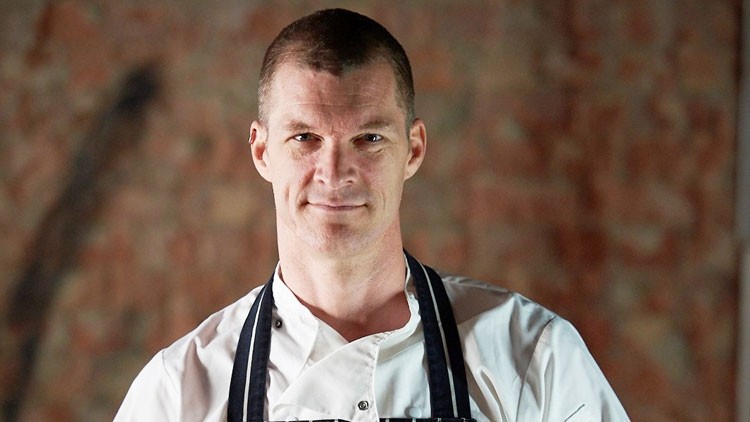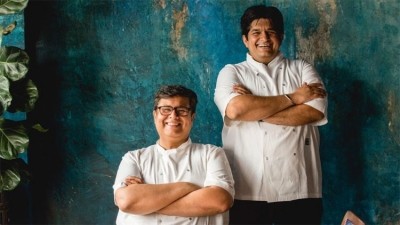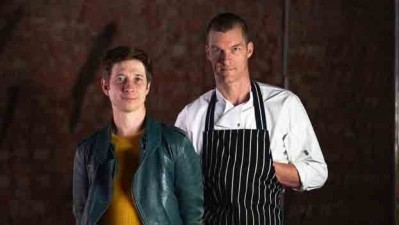Chris Gillard: "If I'm going to stand up and be counted, I need to put my name to something"

You left St John in 2016, what have you been up to since then?
I worked at Quo Vadis for bit and then headed up the kitchen at Andrew Edmunds. I also helped launch Farmacy (a plant-based, health-focused restaurant in Notting Hill) as a consultant. They knew roughly what they wanted, I just helped them deliver it.
Farmacy is quite a departure from St John?
Indeed. St John played a big role in popularising offal and less obvious cuts. If you are going to cook with meat, it must be sourced carefully from producers that have given it a happy life and it must be respected throughout the supply chain. The thing that is the real horror is the industrialisation of meat production. It almost goes without saying that every bit of an animal should be used. But, oddly for someone that’s been so associated with meat cookery, I’ve always been interested in vegetarian and vegan food. I was a vegetarian for most of my teenage years; partly because I was listening to a lot of The Smiths, which dates me a bit. That’s actually how I got into cooking in the first place. My sister was a fussy eater, and my mum said it was fine for me to choose a different diet but that I’d have to cook for myself.
Why did you spend so long at St John?
I was given a great deal of creative freedom there. Fergus (Henderson, St John co-founder) was only really in the kitchen for the first few years I was there. He set the parameters and was in for lunch nearly every day, but as long as what I was producing was to brief, it went on the menu. I was also able to do a few side projects. I ran various restaurants at festivals including a silver service restaurant at Lost Vagueness (a mini festival within Glastonbury).
It was great fun, people would stumble up through the mud but we insisted they must be dressed up for dinner. People at festivals expect warm beer and bad burgers, but we had a wine list and served decent vegetarian food.
What was the catalyst for leaving St John?
After 15 and a half years I was beginning to feel a bit institutionalised. Amazing though the place is, it was time for a change.
Why did you then continue to work for other people? Surely you had the profile to do your own thing?
I’m pretty sure I could have found someone to back me, but I’ve always been happy to hide behind a more high-profile person. The limelight has never really appealed to me. But, over time, I’ve realised that if I’m going to stand up and be counted for the things that I believe in then I need to put my name to something.
How did the Dalston project come about?
I was quite happy working with Andrew Edmunds in Soho. But I was approached by Auro Foxcroft (the founder of Shoreditch live music venue Village Underground and the person behind the regeneration of the former Hackney Arts Centre on Kingsland Road). We met at the site and the space for the restaurant was incredible; the architecture is dramatic because the room is underneath tiered seating (the art deco building was originally a cinema). I’ve lived in east London for many years and the community aspect of the project – it’s a multi-use space with a theatre – appealed, too.
Describe what Earth Kitchen is all about
It’s going to be an informal café by day because the lunchtime trade in that bit of town is not that strong. In the evening it will be much more of a restaurant, and even later it will transform again, serving a bar menu and cocktails. It’s a chance to bring together all the things I’ve learnt throughout my career. It’s a big space, around 130 covers. It will be a really social, informal restaurant.
What style will the food be?
It will be modern European rather than modern British. At Andrew Edmunds, I was reacquainting myself with Italian and Spanish food. It’s time to open it up and have a bit of fun. I like the idea of exploring what British food actually is in 2018. Starters will be sharing but the mains will be more à la carte in style.
When will it open?
We were due to open the restaurant in September, but we’ve had a few setbacks so now we’re looking at early December, which is a tricky time to open a restaurant but we’ll make it work. The rest of the venue is already up and running but the restaurant is the most complicated part of the whole build. The building was constructed in 1936 and the builders have hit a few stumbling blocks that have meant they’ve had to totally revise their plans. Some parts of the site have been left to the pigeons for over 40 years, so breathing new life into it has been very exciting.
This interview first appeared in the December 2018 issue of Restaurant magazine, the leading title for the UK's restaurant industry. For more features, comment, interviews and in-depth analysis of the sector subscribe to Restaurant magazine here.


























